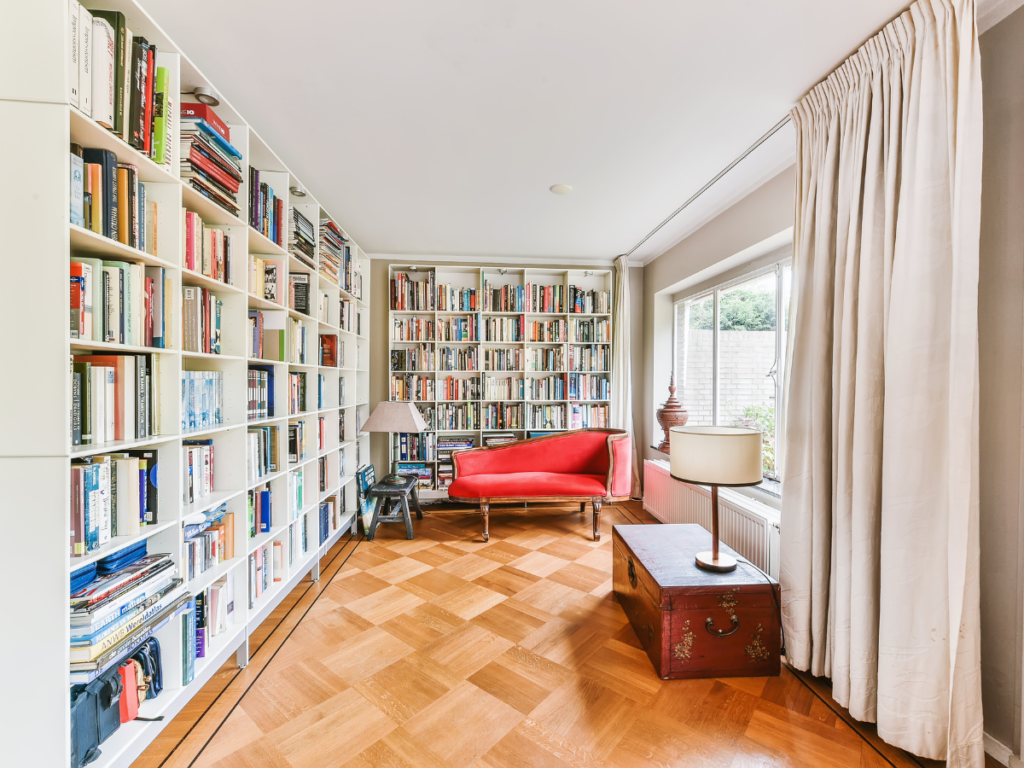Having a personal library at home is the dream of everyone who enjoy reading book. Of course, it allows you to store books, but it is also an excellent decoration asset.
In this article, we will share with you tips that will help you create a library at home that is practical and stylish.
Start by asking yourself the right questions
To create a library at home, it is not enough to simply put books on shelves. Before you start to put things away, you need to consider certain criteria that will allow you to obtain a library that is as functional as it is aesthetic. To do so, ask yourself the following questions:
- In which room would you like to set up your library?
- How many books would you like to store? What is their weight? What is their size?
- How would you like to store them? There are several solutions: alphabetical letter, size, theme, or even language, if necessary.
- Would you like to acquire classic bookcase or shelf models or do you prefer an original and personalized library?
- What style will best match the decoration of your home?
- How much space should be reserved for the books that you purchase in future?
By answering these questions, you can make the plan and design of your personal library.

The different types of libraries
To satisfy everyone’s needs and tastes, manufacturers offer various library models.
- The classic library: This type of library is the most common model. Relatively affordable, this piece of furniture is equipped with several shelves adapted to the storage of books, documents and various objects. It fits perfectly in the living room or entrance hall.
- The wall-mounted bookcase: finding its place in all the rooms of the house, the wall-mounted or suspended bookcase is screwed or hung on the wall. Its disadvantage lies in its low resistance to heavy loads.
- The modular bookcase: is recommended for people who want to change their decoration regularly. You can move the modular bookcase according to your desires.
Which location should I use for my personal library?
Most parts of your house will do with a few exceptions. While it’s refreshing to read in a room with large windows and lots of light, storing books in natural light at night is refreshing.
The choice of a library also depends on its future location. Indeed, one does not choose the same piece of furniture to equip all the rooms of the house.
- In the living room: In a living room, the library often has a function other than the storage of books. As it also contains decorative objects, the bookcase should be matched with the other furniture in the room.
- In the corridor: a space where space loss is at its peak, the corridor is ideal for the installation of a library. This option is particularly useful if the corridor near the bedrooms. To avoid the cabinet taking up too much space across the width, especially in a narrow corridor, a bookcase with a shallow depth is recommended. On the other hand, you can optimize the storage possibilities by opting for a piece of furniture with a height up to the ceiling.
- In a bed room: for reading lovers, the room is ideal for a library also. It motivates you to read when you wake up
- In a dedicated room: for those who plan to set up an entire room for reading, the installation of shelving on all walls is possible. The library can have a height up to the ceiling. In this case, the highest shelves will only be accessible with a stepladder or ladder.
The dimensions of the library
You should study several points before purchasing a library. Indeed, the dimensions depend mainly on the number of books to be stored, but also on the size of the largest books.
Here is an indication, the height of a comic book is around 30 cm (centimeters). On the other hand, a paperback rarely exceeds 20 centimeters. The space available for the installation of the library should also be taken into account when choosing the size of the piece of furniture. For those who plan to acquire more books over time, a library with adjustable shelves is the best option (modular bookcase).
How to decorate your library?
Here are all our tips to have a functional and ultra-trendy library:
- Group your books by size, colors, collections, publishers, or themes – whichever you prefer – and create harmony.
- Alternate book shelves and decorative niches to avoid monotony. Your photos, travel souvenirs or favorite objects will fit perfectly in a library.
- Put your most beautiful books in the spotlight by placing the cover in front of you. A book with a shimmering cover can become a decoration in itself.
- Mix closed and open niches and play with the colors of the edges and walls for more originality!
- Hide non-decorative objects such as cables, multimedia accessories or paperwork in pretty lockers.
- Add a touch of greenery to your room by including green plants in your library. Make sure the plants have enough light to flourish.
In short, let your creativity speak for itself so that your library is like no other!
Choose the type of storage
The choice of storage is essential for a perfectly organized library. Depending on the needs, it is possible to opt for simple shelves or a bookcase. Different parameters are to be taken into account in the choice of the furniture:
- For those who are used to separating themselves from the books they read, shelves are recommended. On the other hand, a fairly large library with shelves of different heights is recommended for those who keep all the books they read.
- It is preferable to choose models made of sturdy materials such as steel or solid wood with a thickness of at least 2 cm. The solidity of the shelves is essential to avoid their deformation under the weight of the books.
- For the conservation of valuable books, it is recommended to invest in a closed cabinet to protect them from UV rays and dust.
Take into account the height of the shelves
When installing a bookcase, it is also recommended to choose a cabinet with shelves of different heights. As books are not all the same size, it is interesting to position the shelves at different heights: 25 cm for paperbacks and 50 cm high for large formats.
Sort books to save space
For a perfectly tidy and organized library, it is necessary to get rid of the superfluous. It is therefore advisable to sort out and remove books that do not interest us or tourist guides that are several years old. Rather than throwing them away, we can consider :
- Reselling your books: it is possible to sell them online, on websites.
- Donate your books: they can be donated to a neighborhood library, a youth area or even to charitable associations. Children’s books can be donated to a school or a nursery assistant.
Choosing a Classification System for your Books
You can organize and store books using different systems. In addition, regardless of the storage system chosen, each book should be thoroughly cleaned before being placed in the library. To do so, it is recommended to clean them with a vacuum cleaner equipped with a soft brush. On the other hand, humidity should be avoided to avoid damaging the books.
By Genres and type
This method is intended for readers who appreciate several genres. It is a question of classifying on the same shelf love novels, thrillers, detective novels… It is also possible to organize the classification of books according to their type: novels, essays, magazines, comic books, manga.
By author
This classification system greatly facilitates the use of the library. To find your way around easily, simply arrange your books according to the alphabetical order of the author’s last name. For perfectionists, if you own several novels by the same author, you must also arrange the titles of these books in alphabetical order.
By publishing house
For those who like certain publishing houses, you can choose to group them together.
By color
For a trendy library, the classification of books by grouping them according to the color of their cover is a must. If the owner does not have more than 5 books of the same color, it is possible to arrange the books by making light vs. dark color contrasts. Covering books with the same paper is also an excellent alternative for a completely monochrome library. However, in this case, the search for a particular book can be difficult.
By number of pages
It is possible to group books of the same size together, for example large books, or to create a nice visual effect by alternating the size of the books.
In chronological order and date of publication
For those whose library is mainly composed of history books, the books can be arranged chronologically according to the period they cover. A classification according to the date of publication of a book is also possible, especially if the books are described as classics.
By order of arrival
To store books while exercising one’s memory, it is possible to place them on the library according to the date of acquisition or reading. Thus, a book read during childhood will be placed at the very beginning of the shelves.
Separate the books read from those to be read
Many reading enthusiasts tend to acquire new books when they have not yet finished the one they are reading. Depending on their number, these books may take up space. To store and find them easily, it is advisable to devote a separate shelf on the library to them.
Dedicate a space to children’s books
For those who have young children, it is advisable to dedicate the bottom shelves of the library to books dedicated to them. In fact, this system prevents the toddlers from having to climb on a chair to reach the upper shelves. This trick allows them to select their books independently.
Make room on the shelves of his library
When storing books, it is important to remember to leave empty shelves to accommodate future acquisitions. In particular, it is advisable to leave a little space on each shelf to avoid moving everything around when a new book is placed on it.
Organize your book collection electronically
Want to know what’s in your library in one click? Many online software and programs are available to help you maintain an inventory of your collection. Here are a few examples.
- Online programs: LibraryThing 200 books can be cataloged with the free package. With the paid version you can catalogue an unlimited number of books. Shelfari and Reader2 are also great free options. You can search books by title, ISBN number, and authors, then add them to a virtual library. These online platforms also gives you the opportunity to socialize with other people who have the same books. You can browse through their collections if you want!
Organizing your collection electronically can help you keep records of your holdings or replace books in the event of a disaster.

